
Walker Simplifies Emissions System Diagnosis, Repair
Tenneco’s Walker Emissions Control brand is helping automotive service providers simplify emissions control diagnosis and repair through a variety of new educational tools, including a recommended set of five checks to perform before...
Tenneco’s Walker Emissions Control brand is helping automotive service providers simplify emissions control diagnosis and repair through a variety of new educational tools, including a recommended set of five checks to perform before installing a replacement catalytic converter. These diagnostic checks are covered in a free technical video available through the “TennecoInc” channel at YouTube.com.
“Our five diagnostic checks are designed to help shops eliminate comebacks by identifying and correcting issues that might have damaged the original converter and could quickly cause a replacement converter to fail as well,” said Joe Bacarella, manager, Technical Assistance Call Centers, North America Aftermarket, Tenneco. “These checks should be a formal part of every emissions system diagnosis.”
The Walker brand’s recommended five emissions system checks are:
1. Retrieve all powertrain control module (PCM) trouble codes and perform corresponding repairs. As part of this process, Tenneco also recommends checking for and performing any available PCM emissions-related reflash updates before installing a new converter.
2. Eliminate all exhaust system leaks. Leaks as small as a pinhole could introduce excess oxygen into the exhaust stream, triggering a P0420 code. Be particularly careful to check for leaks both upstream and within 18 inches downstream of the converter. Leaks can be identified through the use of a smoke machine, by performing a thorough visual inspection or pressurizing the system with compressed air.
3. Confirm the engine is in proper fuel control. An air/fuel mixture that is slightly rich or lean can trigger a trouble code and cause converter damage. This check can be performed with a four- or five-gas analyzer, many modern scan tools or a high-impedance digital Volt-Ohm meter. If using a gas analyzer, the Lambda reading should not fall outside a range of 0.995 to 1.005 and the hydrocarbon reading should be between zero and 35 parts per million.
4. Identify and correct any engine-related issues that could lead to converter contamination. Begin by performing a cooling system pressure check, which can indicate whether coolant could be leaking into the combustion chamber. When conducting this test, the system should hold the specified cap pressure for at least 15 minutes. Also check for excessive oil consumption by testing the overall mechanical condition of the engine. This can be assessed through a simple volumetric efficiency test.
5. Be sure you have the correct converter for the vehicle. Double check the vehicle’s year, make, model, engine and emissions certification, then select the corresponding EPA-compliant converter listed in your Walker Ultra Catalytic Converter catalog. If your shop is located in a state that follows California Air Resources Board (CARB) standards, you must also check the EFN (engine family number), sometimes referred to as “group number,” before selecting the appropriate CARB-compliant converter from the Walker CalCat Catalytic Converter catalog.
“A vast majority of emissions service comebacks are avoidable, and by following these steps shops can dramatically increase the likelihood of eliminating all issues the first time,” Bacarella said. “It’s important to remember that catalytic converters rarely, if ever, fail on their own. This new process will protect the replacement converter from contamination and other damage, which will lead to long, trouble-free service for the shop and consumer.”
.png)






Have your say: